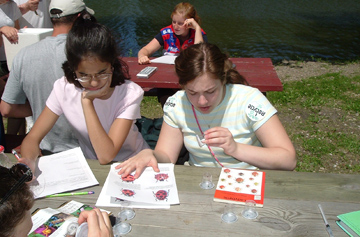LLP Nonfiction Book List - 2012
(Books are roughly in order by audience age and reading level.)
LADYBUGS Teachers Guide, Preschool-1. By Jean C. Echols. GEMS Lawrence Hall of Science, University of California at Berkeley. A wonderful preschool through first grade curriculum and teachers activity book with coloring pages, posters, literature connections, and assessment ideas: http://lawrencehallofscience.stores.yahoo.net/ladybugs.html. Many of the ideas could also be adapted for older children. Multicultural representation in illustrations.

Young Ladybug Spotters at Nardin
Look for Ladybugs (Rookie Readers) by Dana Meachen Rau and Christine Schneider. Children’s Press, Scholastic Inc. This one is terrific for preschool - first grade! Ladybug search with rhyming and prepositional phrases! Multicultural representation in illustrations.
Ladybugs and Other Insects by Gallimard Jeunesse and Sylvaine Peyrols. Scholastic First Discovery. Simple text, some cool transparent pages to illustrate concepts.
Starting Life: Ladybug by Claire Llewellyn. Cooper Square Publishing. Beautiful scientific paintings, packed with information, interesting format with die-cut pages that get longer. Excellent, a must.
Are You a Ladybug? by Judy Allen and Tudor Humphries. Backyard Books. Whimsical, contains scientific information and the concept of development. Multicultural representation in illustrations.
Ladybugs (Minibeasts) by Claire Llewellyn and Barrie Watts. Children's Press. Good photographs and information. Nice complement to have alongside the illustrated books.
What About Ladybugs? by Celia Godkin. Sierra Club Books. Story shows the dramatic effect of pesticides on the balance of garden life. Good drawings of aphids.
Ladybug at Orchard Avenue by Kathleen Weidner Zoehfeld. Smithsonian”s Backyard. Rich text for literacy, a story with lots of facts. Good for upper elementary students.
Ladybugs of Alberta: Finding the Spots and Connecting the Dots (Alberta Insects Series) by John Acorn. University of Alberta Press. This is a must for older kids and adults. It is the only real guide to ladybug identification in print and contains most common species. It is a delightful read by a spirited naturalist and includes a rhyme for each species!
Important books we use to frame our programs:
Girls Who Looked Under Rocks The Lives of Six Pioneering Naturalists. By Jeanine Atkins. DAWN Publications. Nevada City, California.
Black and Brown Faces in America’s Wild Places By Dudley Edmondson. Adventure Publications, Inc. Cambridge, Minnesota.
Giving Thanks: A Native American Good Morning Message By Jake Swamp. Lee and Low Books.
Citizen Scientists: Be a Part of Scientific Discovery from Your Own Backyard By Loree Griffin Burns, Ellen Harasimowicz. Henry Holt and Co.
General insect guides to have in the field:
First Field Guide: Insects (Audubon Guides) Christina Wilsdon. Scholastic Reference.
Peterson First Guide to Insects of North America (Peterson First Guide) Christopher Leahy, Roger Tory Peterson, Richard E. White. Houghton Mifflin Harcourt
Please send your nonfiction ladybug book suggestions to ladybug@cornell.edu
